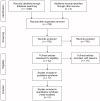Records needed for orthodontic diagnosis and treatment planning: a systematic review
- PMID: 24265669
- PMCID: PMC3827061
- DOI: 10.1371/journal.pone.0074186
Records needed for orthodontic diagnosis and treatment planning: a systematic review
Abstract
Background: Traditionally, dental models, facial and intra-oral photographs and a set of two-dimensional radiographs are used for orthodontic diagnosis and treatment planning. As evidence is lacking, the discussion is ongoing which specific records are needed for the process of making an orthodontic treatment plan.
Objective: To estimate the contribution and importance of different diagnostic records for making an orthodontic diagnosis and treatment plan.
Data sources: An electronic search in PubMed (1948-July 2012), EMBASE Excerpta Medica (1980-July 2012), CINAHL (1982-July 2012), Web of Science (1945-July 2012), Scopus (1996-July 2012), and Cochrane Library (1993-July 2012) was performed. Additionally, a hand search of the reference lists of included studies was performed to identify potentially eligible studies. There was no language restriction.
Study selection: The patient, intervention, comparator, outcome (pico) question formulated for this study was as follows: for patients who need orthodontic treatment (P), will the use of record set X (I) compared with record set Y (C) change the treatment plan (O)? Only primary publications were included.
Data extraction: Independent extraction of data and quality assessment was performed by two observers.
Results: Of the 1041 publications retrieved, 17 met the inclusion criteria. Of these, 4 studies were of high quality. Because of the limited number of high quality studies and the differences in study designs, patient characteristics, and reference standard or index test, a meta-analysis was not possible.
Conclusion: Cephalograms are not routinely needed for orthodontic treatment planning in Class II malocclusions, digital models can be used to replace plaster casts, and cone-beam computed tomography radiographs can be indicated for impacted canines. Based on the findings of this review, the minimum record set required for orthodontic diagnosis and treatment planning could not be defined.
Systematic review registration number: CRD42012002365.
Conflict of interest statement
Figures
Similar articles
-
Technological aids for the rehabilitation of memory and executive functioning in children and adolescents with acquired brain injury.Cochrane Database Syst Rev. 2016 Jul 1;7(7):CD011020. doi: 10.1002/14651858.CD011020.pub2. Cochrane Database Syst Rev. 2016. PMID: 27364851 Free PMC article.
-
Eliciting adverse effects data from participants in clinical trials.Cochrane Database Syst Rev. 2018 Jan 16;1(1):MR000039. doi: 10.1002/14651858.MR000039.pub2. Cochrane Database Syst Rev. 2018. PMID: 29372930 Free PMC article.
-
Interventions for the cessation of non-nutritive sucking habits in children.Cochrane Database Syst Rev. 2015 Mar 31;2015(3):CD008694. doi: 10.1002/14651858.CD008694.pub2. Cochrane Database Syst Rev. 2015. PMID: 25825863 Free PMC article.
-
Initial arch wires used in orthodontic treatment with fixed appliances.Cochrane Database Syst Rev. 2018 Jul 31;7(7):CD007859. doi: 10.1002/14651858.CD007859.pub4. Cochrane Database Syst Rev. 2018. Update in: Cochrane Database Syst Rev. 2024 Feb 06;2:CD007859. doi: 10.1002/14651858.CD007859.pub5. PMID: 30064155 Free PMC article. Updated.
-
[Volume and health outcomes: evidence from systematic reviews and from evaluation of Italian hospital data].Epidemiol Prev. 2013 Mar-Jun;37(2-3 Suppl 2):1-100. Epidemiol Prev. 2013. PMID: 23851286 Italian.
Cited by
-
Does Orthodontic Treatment Affect the Alveolar Bone Density?Medicine (Baltimore). 2016 Mar;95(10):e3080. doi: 10.1097/MD.0000000000003080. Medicine (Baltimore). 2016. PMID: 26962841 Free PMC article.
-
Effectiveness of Dental and Maxillary Transverse Changes in Tooth-Borne, Bone-Borne, and Hybrid Palatal Expansion through Cone-Beam Tomography: A Systematic Review of the Literature.Medicina (Kaunas). 2021 Mar 19;57(3):288. doi: 10.3390/medicina57030288. Medicina (Kaunas). 2021. PMID: 33808680 Free PMC article.
-
The Efficacy of Diagnostic Plaster Models in Orthodontic Diagnosis and Treatment Planning.Diagnostics (Basel). 2024 Sep 25;14(19):2124. doi: 10.3390/diagnostics14192124. Diagnostics (Basel). 2024. PMID: 39410527 Free PMC article.
-
CBCT in orthodontics: assessment of treatment outcomes and indications for its use.Dentomaxillofac Radiol. 2015;44(1):20140282. doi: 10.1259/dmfr.20140282. Dentomaxillofac Radiol. 2015. PMID: 25358833 Free PMC article. Review.
-
A Deep Learning Framework for Automated Classification and Archiving of Orthodontic Diagnostic Documents.Cureus. 2024 Dec 28;16(12):e76530. doi: 10.7759/cureus.76530. eCollection 2024 Dec. Cureus. 2024. PMID: 39877794 Free PMC article.
References
-
- Graber TM, Vanarsdall RL, Vig KWL (2000) Orthodontics: Current principles & techniques, fourth edition. St. Louis: Mosby, Inc. pp. 3–70.
-
- Proffit WR, Fields HW Jr, Sarver DM (2007) Contemporary orthodontics, fourth edition. St. Louis: Mosby, Inc. pp. 167–233.
-
- Cobourne MT, DiBiase AT (2011) Handbook of orthodontics. Philadelphia: Mosby Elsevier. pp. 125–179.
-
- Van Vlijmen OJC, Kuijpers MAR, Bergé SJ, Schols JGJH, Maal TJJ, et al. (2012) Evidence supporting the use of cone-beam computed tomography in orthodontics. J Am Dent Assoc 143: 241–252. - PubMed
Publication types
MeSH terms
LinkOut - more resources
Full Text Sources
Other Literature Sources
Medical
Research Materials
Miscellaneous




